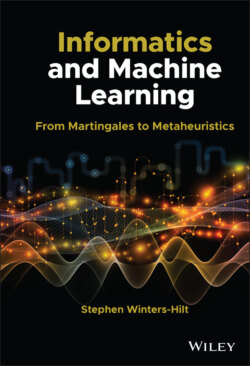Читать книгу Informatics and Machine Learning - Stephen Winters-Hilt - Страница 11
1 Introduction
ОглавлениеInformatics provides new avenues of understanding and inquiry in any medium that can be captured in digital form. Areas as diverse as text analysis, signal analysis, and genome analysis, to name a few, can be studied with informatics tools. Computationally powered informatics tools are having a phenomenal impact in many fields, including engineering, nanotechnology, and the biological sciences (Figure 1.1).
In this text I provide a background on various methods from Informatics and Machine Learning (ML) that together comprise a “complete toolset” for doing data analytics work at all levels – from a first year undergraduate introductory level to advanced topics in subsections suitable for graduate students seeking a deeper understanding (or a more detailed example). Numerous prior book, journal, and patent publications by the author are drawn upon extensively throughout the text [1–68]. Part of the objective of this book is to bring these examples together and demonstrate their combined use in typical signal processing situations. Numerous other journal and patent publications by the author [69–100] provide related material, but are not directly drawn upon this text. The application domain is practically everything in the digital domain, as mentioned above, but in this text the focus will be on core methodologies with specific application in informatics, bioinformatics, and cheminformatics (nanopore detection, in particular). Other disciplines can also be analyzed with informatics tools. Basic questions about human origins (anthrogenomics) and behavior (econometrics) can also be explored with informatics‐based pattern recognition methods, with a huge impact on new research directions in anthropology, sociology, political science, economics, and psychology. The complete toolset of statistical learning tools can be used in any of these domains.
In the chapter that follows an overview is given of the various information processing stages to be discussed in the text, with some highlights to help explain the order and connectivity of topics, as well as motivate their presentation in further detail in what is to come.
Figure 1.1 A Penrose tiling. A non‐repeating tiling with two shapes of tiles, with 5‐point local symmetry and both local and global (emergent) golden ratio.
